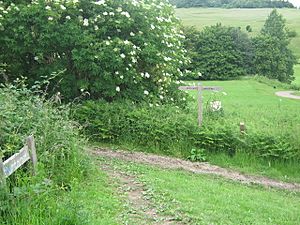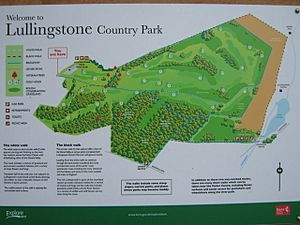Lullingstone Country Park facts for kids
Quick facts for kids Lullingstone Country Park |
|
|---|---|
 |
|
| Area | 186 hectares (460 acres) |
| Created | 1960's |
| Operated by | Kent County Council, |
| Open | 7 days a week, dawn until dusk |
| Website | Lullingstone Country Park |
| Site of Special Scientific Interest | |
| Area of Search | Kent |
|---|---|
| Interest | Biological |
| Area | 66.4 hectares (164 acres) |
| Notification | 1989 |
| Location map | Magic Map |
Lullingstone Country Park is a beautiful place near Eynsford, in Kent, England. It used to be a deer park for a big estate. Later, it became a public park with open fields and woodlands. The park and Lullingstone Castle are special historical sites called a Scheduled monument. A large part of the park (about 66.4 hectares (164 acres)) is also a biological Site of Special Scientific Interest because of its amazing nature.
Contents
Park History: From Deer Park to Public Space
This big park, about 460 acres, is located between Eynsford and Shoreham. Long ago, in the Middle Ages, it was a deer park. It was part of the Lullingstone estate, which was even mentioned in the Domesday Book (a famous survey from 1086).
In 1934, a lot of the park was sold to a company called Kemp Town Brewery. They later sold it to Kent County Council in 1938.
Lullingstone Park During World War II
During World War II in 1944, something interesting happened here. A fake airfield was built in the park to trick enemy planes. Lullingstone Castle was also used by the army. German bombs hit the Lullingstone estate several times. Most of the holes they made have been filled in. One bomb crater is now hidden by trees.
Modern Changes and Discoveries
In the mid-1960s, Kent County Council rented the park to Dartford Rural District Council. They built an 18-hole golf course in the park. Later, a 9-hole course was added too. These golf courses are still in the western and central parts of the park today.
Currently, Sevenoaks District Council rents the park. However, Kent County Council helps keep it in good shape. Lullingstone Castle and its grounds are still privately owned by the Hart-Dyke family.
In 1964, a grassy hill in the park called Summerhouse Knoll was explored by archaeologists. They found pottery from the 1st Century, which is very old!
Some of the trees in the wood are over 400 years old. These old trees are very important for many small creatures, plants like lichens, birds that nest there, and different kinds of fungi. More than 340 types of beetles have been found here. Two of these beetle types are very rare in the whole country.
Exploring Lullingstone: Nature and Trails
The park is famous for its collection of very old trees. These include about 300 ancient oaks, beeches, hornbeams, ash trees, and sweet chestnut trees. Some of these trees are thought to be around 500 years old! Besides the woodlands, the park has large open meadows. These meadows are full of different plants, including beautiful orchids and other native wildflowers. Many butterflies also live here.
River Darent and Its Wildlife
The River Darent flows through the eastern part of the park. The Darent Valley Path, a long walking trail, runs alongside it. Some parts of the river have been made wider to create small lakes and ponds. These water areas attract lots of wildlife. You might see kingfishers, herons, grass snakes, dragonflies, and damselflies here.
Walking and Horse Trails
There are several marked trails for you to explore in the park:
- The White Woodland Walk is a 2-mile path. It goes through Beechen Wood and past a special area called the Orchid Bank.
- The Black Lullingstone Loop is a 4-mile walk around the edge of the park. It also goes through Beechen Wood (which is a Site of Special Scientific Interest). This trail passes by Lullingstone Roman Villa and Lullingstone Castle. You'll see many of the park's ancient trees on this loop.
- The Red Discovery Trail is a shorter, 1.5-mile trail. It's designed to be fun for children with activities along the way.
- The Blue Horse Trail is 4 miles long and is for horse riding.
There are also other public footpaths you can use to explore the park.
In March 2011, the park hosted a special "Kent Big Weekend Event." The park has also received a Green Flag Award from Natural England. This award shows that it is a well-managed and welcoming green space.
How to Get There
If you are coming from Eynsford, follow the A225 road towards Otford. You will see the park on your right, just after the entrance to Lullingstone Castle. You can also enter the park by walking through Beechens Wood from Redmans Lane, which borders the park on the south side.


